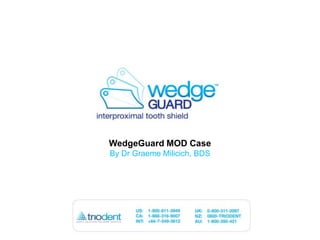
WedgeGuard MOD Case by Dr Graeme Milicich
- 1. WedgeGuard MOD Case By Dr Graeme Milicich, BDS
- 2. 1 A patient presented with an old composite with severe food impaction and associated chronic gingivitis. The restoration needed replacing. The adjacent teeth were unrestored on the proximal surfaces. To avoid the risk of any damage to the adjacent teeth, the New WedgeGuard from Triodent was used.
- 3. 2 The interproximal guards are attached to the Wave-Wedges we already know, and are coded for size as per the original Wave-Wedges. The appropriate sized WedgeGuard is selected and slid interproximally until seated.
- 4. 3 The metal blade of the WedgeGuard will now protect the adjacent tooth from any inadvertent damage during cavity preparation. Iatrogenic damage reported in the literature ranges from approximately 50% of cavity preparations up to a high in excess of 90%.Access can be improved by adjusting the guard with a high-speed diamond once it has been placed into position.
- 5. 4 The metal guard protects the adjacent tooth and the plastic Wave-Wedge helps prevent laceration of the interdental papilla. Note that the floor of the old cavity was lower than the position of the wedge, which protected the papilla and provided excellent visualization of access to the cavity margin where laceration of interproximal tissue in the sub-gingival preparations can be an issue.
- 6. 5 Once the cavity preparation is completed, the guard is removed with a pair of Pin-Tweezers. Prior to placing the V3 Tab-Matrix, pull the Wave-Wedge out until it is lightly located, place the matrix and then reposition the Wave-Wedge.
- 7. 6 Note, the WedgeGuard is not designed to be used as a matrix following cavity preparation because the guard is located in the middle of the wedge, which could create a large overhang. Also, the thickness of the metal guard is such that it would leave an open contact once it was removed.
- 8. 7 Place the V3 separator rings and continue to complete the restoration as normal.
- 9. 8 Continue as normal.
- 10. 9 Remove V3 tab-Matrices.
- 11. 10 The WedgeGuard is a novel, effective and efficient way to safely prepare a cavity and then restore it by using a two-phase component without incurring the additional expense of two separate components as is required with other interproximal protection systems.
